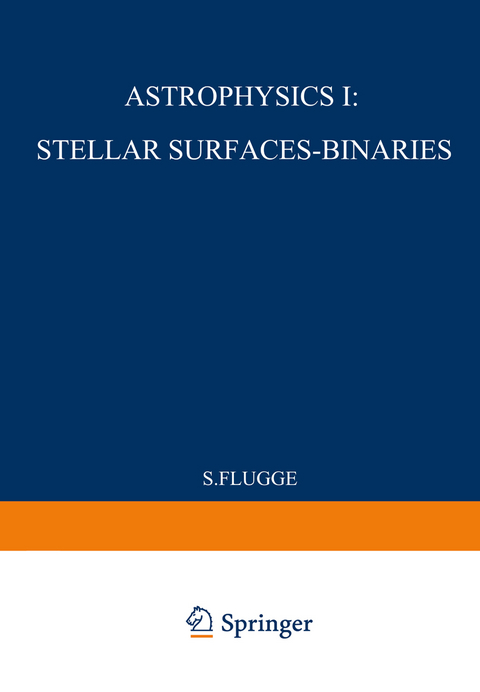
Astrophysik I: Sternoberflächen-Doppelsterne / Astrophysics I: Stellar-Surfaces-Binaries
Springer Berlin (Verlag)
978-3-642-45907-8 (ISBN)
Les classifications spectrales des étoiles normales.- I. La théorie du type spectral.- II. Les premières classifications d'apres I'aspect des spectres.- III. Comparaison de classifications spectrales.- IV. La variation du type spectral avec T? et P?.- V. Les classifications d'Upsal et de Stockholm.- VI. Les classifications à deux dimensions dérivées de Harvard.- VII. La classification des spectres très peu dispersés.- VIII. Classification par le spectre continu des étoiles.- IX. La classification des étoiles par photométrie.- X. Classification des étoiles à raies anormalement fortes ou faibles.- XI. Conclusion.- Bibliographie générale.- Stars with Peculiar Spectra.- General references.- Les bandes moléculaires dans les spectres stellaires.- I. Bandes moléculaires dans le spectre solaire.- II. Utilisation des bandes moléculaires pour la classification spectrale; description générale des bandes stellaires.- III. Absorption continue due aux molécules.- IV. Déterminations de températures basées sur les bandes moléculaires.- V. Interprétation du comportement des bandes moleculaires dans les étoiles froides.- Conclusions.- Bibliographie.- Die Spektren der planetarischen Nebel.- I. Allgemeine Eigenschaften der planetarischen Nebel.- II. Die Spektren der planetarischen Nebel.- Literatur.- The Spectra of the White Dwarfs.- I. Introduction.- II. Relevant observational data.- III. The spectroscopic results.- IV. Description of typical spectra.- V. Theoretical interpretations.- General bibliography.- Visual Binaries.- I. Observational.- II. Theoretical.- III. Analysis of relative orbit.- IV. Analysis of orbit referred to external reference system.- V. Masses and luminosities of visual binaries.- VI. Special topics.- General references.- TheEclipsing Binaries.- 1. Introduction.- 2. Definitions.- 3. Formulae used in computing the elements.- 4. The absolute dimensions of eclipsing variables.- 5. Eclipsing variables and astrophysical problems.- 6. Population of eclipsing variables in the galaxy.- 7. Eclipsing binaries in other galaxies.- 8. Conclusion.- Spectroscopic Binaries.- 1. Introduction.- 2. The determination of orbital elements.- 3. Apsidal motion.- 4. The determination of stellar masses.- 5. Rotation of binary stars.- 6. Peculiar line profiles.- 7. The luminosities of binary stars from spectroscopic studies.- 8. Departures from the mass-luminosity relation in close binary stars.- 9. Statistical studies of spectroscopic binaries.- 10. Gaseous motions and other effects.- 11. The nature of emission lines in close binaries.- 12. The peculiar system UX Monocerotis.- 13. Recent developments regarding the evolution and origin of binary stars.- 14. Concluding remarks.- General references.- Théorie générale des atmosphères stellaires.- Bibliographie générale.- Theorie der planetarischen Nebel.- I. Die mathematische Formulierung der wichtigsten Elementarprozesse in den Nebelhüllen.- II. Zur Theorie des Strahlungsumsatzes in den Nebelhüllen.- III. Theorie der Ionisationsschichtung.- IV. Die Zanstra-Theorie (Temperaturen der Zentralsterne).- Zusammenfassende Darstellungen.- Sachverzeichnis (Deutsch-Englisch).- Subject Index (English-German).- Table des Matières (Français).
| Erscheint lt. Verlag | 1.3.2012 |
|---|---|
| Reihe/Serie | Astrophysik / Astrophysics | Handbuch der Physik Encyclopedia of Physics |
| Zusatzinfo | VIII, 458 S. |
| Verlagsort | Berlin |
| Sprache | deutsch |
| Maße | 170 x 244 mm |
| Gewicht | 800 g |
| Themenwelt | Naturwissenschaften ► Physik / Astronomie ► Allgemeines / Lexika |
| Schlagworte | Astrometrie • astrophysics • Astrophysik • Doppelstern • Stern • Sternoberfläche |
| ISBN-10 | 3-642-45907-2 / 3642459072 |
| ISBN-13 | 978-3-642-45907-8 / 9783642459078 |
| Zustand | Neuware |
| Haben Sie eine Frage zum Produkt? |
aus dem Bereich


